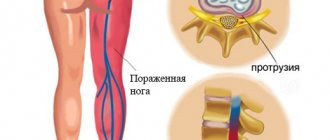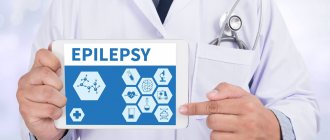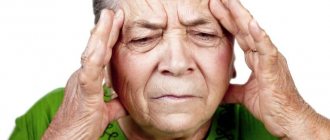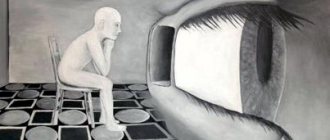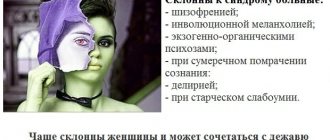Episyndrome is a pathological condition of the nervous system, characterized by paroxysms of focal excitation of brain neurons. Clinically manifested by attacks of convulsions, sensory, vegetative, and mental manifestations. Etiological factors in the development of pathology may be brain tumors, traumatic brain injuries or injuries to the cervical spine, vascular or metabolic disorders, and intoxication. Treatment can be conservative or surgical, aimed at relieving the manifestations of the underlying disease and eliminating individual symptoms. The prognosis depends on the etiology, but is favorable with timely and adequate treatment.
From history and statistics
In ancient times, epilepsy was treated very warily, considering it a mental illness.
Such people were avoided and humiliated in every possible way, believing that this disease was “from the devil.” Many countries with a low level of civilization have not changed their attitude towards this disease to this day, although the achievements of modern medicine have refuted the groundlessness of such stereotypical thinking.
New therapeutic approaches to treatment have radically changed public views in developed countries and contributed to positive social adaptation and alleviation of somatic suffering in patients with epilepsy.
According to doctors, epilepsy is a chronic disorder of brain activity with specific clinical changes in the form of seizures. According to WHO statistics, about 50 million people worldwide suffer from this disease.
Approximately their number ranges from 4 to 9 cases per 1000 people. More than half of patients live in countries with low living standards. Epilepsy cannot be diagnosed with just one seizure. As a rule, they occur more often with a certain gap in time.
Convulsive seizures manifest themselves involuntarily and briefly in the form of involuntary spasms of any part of the body, or the whole body.
Often such convulsive states are accompanied by loss of consciousness, vomiting, and convulsions of the limbs. Seizures can occur at any time of the day. Depending on the clinical course of the disease (main or concomitant), their number ranges from one per year to several paroxysmal seizures per day.
The number of epileptics has increased significantly in the last decade, so research in this area continues. Especially in countries with low living standards (from 7-14 per 1000 people).
Every year, 2.3 million people around the world are diagnosed with epilepsy. Outbreaks of the disease are typical for countries with a high risk of endogenous organic diseases, low level of medical care (birth injuries, lack of emergency assistance in road accidents, financial difficulties in obtaining quality medical care). In 65% of cases, epilepsy can be treated with medication.
Symptoms of epilepsy
How does a chronic disease such as epilepsy manifest itself? Scientists identify a whole range of symptoms for this disease:
- Mental disorders. This can be either stupor or complete loss of consciousness, amnesia, autonomic disorders, psychosis.
- Personality changes. Character and way of thinking changes, emotional disorders may occur, memory and intelligence decrease, mood and mood change.
There are actually very, very many symptoms for this disease. However, they all affect a person’s personality, changing it. In the case of episyndrome, this occurs in a very small proportion.
Etiology of the disease
The causes of epileptic seizures are not fully understood.
Many studies prove the hereditary nature of the disease. In addition to the hereditary factor, scientists consider the conditions of intrauterine development of the fetus and early postnatal trauma to the child’s brain during childbirth or infection in the natal period with a staphylococcal or streptococcal infection as causes. In 25% of cases, the pathogenesis of the disease could not be determined. In general, the researchers were able to create a classification of the main causes of epilepsy.
Among them:
- brain injury during childbirth or the perinatal period;
- congenital genetic developmental abnormalities;
- head injury;
- cerebral hemorrhages;
- meningococcal, encephalitis, streptococcal infections;
- genetic syndromes;
- tumor processes;
- eclampsia;
- alcohol withdrawal.
About epilepsy
First, I would like to pay a little attention to such a problem as epilepsy (episyndrome will be discussed a little later). So, it should be noted that this is a chronic brain disease that is characterized by seizures. The first symptoms may appear in early childhood (5-7 years) or in adolescence (12-13 years) in the case of a congenital disease. In this scenario, the disease is well treated and the patient can completely stop taking the pills after a while. Secondary epilepsy (another type of disease) that develops as a result of injury, disease, infection, or other cause may be more difficult to treat. And it is not always possible to cope with the problem completely.
Main forms of the disease
In medicine, types of epilepsy have been classified based on the probable etiology and location of the brain lesion. The following types of disease are distinguished:
- Focal form . Determined in case of local manifestation. It can be symptomatic (frontal, parietal, temporal, occipital), idiopathic (due to organic brain damage, cryptogenic (without a specific etiology).
- Generalized form . Convulsive conditions in which both hemispheres of the brain are involved.
Symptomatic manifestations
The main episymptom is convulsions with loss of consciousness. Characteristics of additional symptoms indicate a specific area of brain damage.
Conventionally, simple and complex convulsive states are distinguished. In simple cases, short-term convulsions of the head and limbs without loss of consciousness are observed. In complex convulsive seizures, consciousness is completely switched off.
The focal form of epilepsy is accompanied by the following symptoms:
- When the frontal lobes are affected : one half of the body is involved: arms, legs, face, which tense convulsively. Excessive salivation and involuntary screaming appear. The eyes and head move convulsively to the side.
- With a temporal lesion, auditory hallucinations, increased temperature, increased heart rate, sweating, abdominal pain and nausea are observed. Possible impairment of visual acuity, hearing and speech. For sick women, this attack may recur in the premenstrual period. Temporal lobe epilepsy is characterized by sleepwalking.
- Signs of parietal epilepsy are numbness of certain parts of the body, dizziness, loss of spatial orientation, and impaired consciousness.
- In the case of occipital episyndrome, colored circular spots appear on the skin around the eyes, frequent twitching of the eyelids and partial loss of vision.
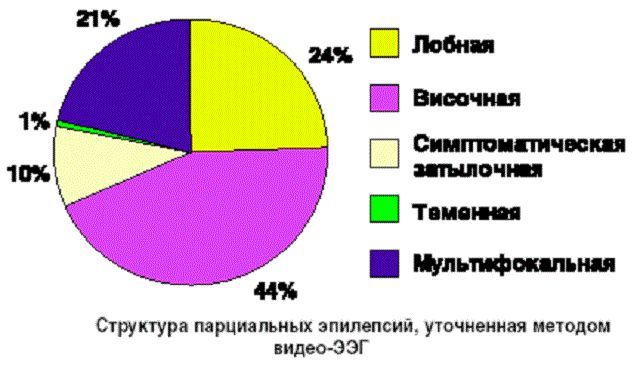
Short-term focal attacks can develop into a complex (generalized) form. Symptomatically, this looks like a complete loss of consciousness, freezing of the victim with open eyes and a “petrified” face.
Next, the patient’s blood pressure increases, foamy discharge from the mouth, involuntary urination and defecation are observed. This condition can last from a few seconds to a minute and goes away on its own. After the attack, the patient regains consciousness, but does not remember what happened to him.
First aid during an attack
In case of a repeated attack or the initial manifestation of the disease, it is sometimes possible to do without an ambulance. If the patient’s consciousness is preserved, they sit him down and ask him about his general well-being. Subject to an adequate assessment, serious measures may not be applied. When there is an unconscious state, adhere to the sequence below:
- Place the adult or child on his back with his head slightly raised (you can use folded clothes). This precaution will help prevent blows and cranial injuries in the event of convulsions.
- A handkerchief is placed in the mouth to prevent tongue biting.
- If there is excessive salivation, turn the head to the side to avoid choking.
- You need to be prepared for a possible one-minute apnea. The situation is under control when breathing resumes after a couple of seconds.
Errors in providing first aid include bringing a person with a seizure to consciousness, stopping a seizure with mechanical forces. Such measures will not give the expected result (just like forcibly opening clenched teeth).
The duration of one attack is on average 3 minutes, during which the main goal of first aid is to exclude injury, maintain the correct position of the tongue, and prevent hypoxia. If you feel better, you can’t get up immediately - you need to maintain a 10-minute interval. Calling an ambulance is justified in the following situations:
- The patient is a woman expecting a baby.
- The attack occurred in an elderly person or a child.
- The duration of the seizures exceeds 3 minutes.
- Unconsciousness persists after 10 minutes.
Diagnosis of episyndrome
To begin with, the doctor collects an anamnesis of the disease: the type of seizure, the conditions for the occurrence of seizures, the cause of this condition, the patient’s feelings.
Next, a neurological examination is performed. As an additional study, electroencephalography of the frontal lobes is prescribed. As a method, completely harmless, but informative, as it determines the lesion and epileptic activity in the cerebral cortex.
Diagnostics are carried out within 20 minutes and different stimuli (sound, visual) are used and the breathing rhythm is changed. This determines possible pathological electrical activity. Diagnosis is carried out in a hospital setting. To compare brain activity indicators, it is carried out during sleep and during the day.
To exclude malignant etiology, computed tomography and magnetic resonance imaging are performed. The latter will help determine circulatory disorders and other structural changes in the cerebral cortex.
Complex of therapeutic measures
Treatment for epilepsy begins after seizures recur. The most commonly prescribed medications are Valproate and Carbamazepine.
After the course of treatment (about a month), Levetiracetam and Topiramate are prescribed. After another month, the general condition of the patient and the nature of the recurrence of attacks are assessed. If convulsive conditions do not stop, one of the drugs is replaced and treatment is continued.
Unfortunately, only this experimental method can select the optimal treatment, which can last up to 3 years. You can take two anticonvulsant medications at the same time. They are considered not entirely harmless and have side effects on the body.
Patients with epileptic symptoms should be examined once a month by a specialized specialist and monitor their general health by related specialists once every six months. If the dynamics of recovery are positive, the doctor may prescribe a lower dose or cancel treatment. If against this background the episymptom is activated, then treatment is continued.
Possible somatic complications
Patients with epistatus are in a “risk group” and may have concomitant somatic disorders:
- Pneumonia . During attacks, small particles of food may enter the respiratory tract. They can provoke an inflammatory process.
- Swelling of the lungs . Convulsions increase blood pressure and oxygen starvation develops. Against this background, pulmonary edema develops.
- Various injuries . During an attack, the patient can damage muscles, break limbs or damage the spine.
- Toxic disorders . Abdominal pain and constipation appear.
- Allergic reactions in the form of dizziness, headaches, fever, fatigue, hives and irritability.
- Psycho-emotional disorders : depression, psychopathy, neurasthenia.
Causes
Key sources of problems in adults include:
- Post-traumatic consequences of damage to the cranial area.
- Tumor processes in the head region.
- Fainting or syncope as a consequence of a heart rhythm disorder.
- Parasitic lesion or abscess of the brain.
- Collapse.
- Hippocampal sclerosis.
If a seizure occurs in a child, symptomatic epilepsy is explained by the following effects:
- Oxygen starvation of the brain or asphyxia.
- Significant increase in body temperature.
- Ingestion of toxic substances into the body.
- Potassium-calcium imbalance.
- Hormonal imbalance.
- An infection dangerous to the head structures, meningitis.
Manifestations of the disease in young children and adolescents are much more pronounced than in adults. This feature is due to insufficient maturity and continued formation of the nervous system.
Preventive measures
Based on the etiology of the episyndrome, you can reduce the risk of developing a symptomatic (acquired) form of the disease. As preventive measures, doctors recommend:
- avoid excessive consumption of alcoholic beverages;
- limit consumption of coffee and fatty foods;
- provide a range of medical procedures for caring for newborns during the perinatal period;
- In order to avoid recurrence of attacks, patients with episyndrome are strictly prohibited from working at heights, on water, contact with industrial poisons, and professional activities that require increased concentration and monotonous actions.
In general, the cause of epileptic seizures can be congenital and acquired factors. Treatment of the disease is symptomatic.
The effectiveness of recovery depends on constant monitoring, the use of medications and preventive measures. For chronic conditions, medications are taken for life.
Treatment options
The choice of treatment tactics is based on several factors, including age, probable cause, and individual course of the attack. Adult patients are offered the following regimen:
- For long-term use, medicinal herbs with a relaxing effect are prescribed. These are wild rosemary, violet, oregano, celandine, linden.
- Plan a diet with limited consumption of liquids, pickles, and smoked foods.
- Prescribed drugs with anticonvulsant and tranquilizing effects. Their purpose is to reduce the frequency of attacks and muscle relaxation, respectively.
Treatment of children involves the following stages:
- Organizing a diet with an emphasis on fatty foods and reducing the amount of protein. Thanks to this diet, lipids become the body's only energy resource. The reduction in the number of seizures occurs due to the active work of internal structures on the formation of ketone bodies.
- Restoration of calcium-potassium balance.
- Herbal medicine using the medicinal plants mentioned above.
The main goal of treatment is to relieve the underlying cause. Only in this case it is possible to eliminate disability, get an effective result and a normal, fulfilling life.

